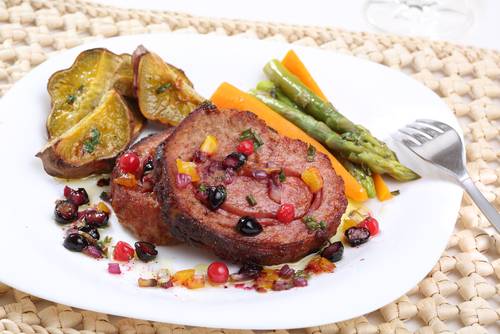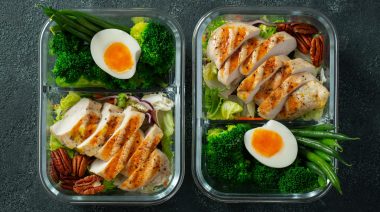In What Is Healthy Eating? Turning the Food Pyramid Upside Down, I explained the story of Dr. Louise Light and how the recommendations she originally submitted to the USDA for the food pyramid got shot down for a number of political reasons.
So, if we believe that Dr. Light was on the right track and that the USDA’s dietary guidelines are not what is right for us, then what is? Let us take a look at the science and attempt to figure this out for ourselves.
The Evolutionary Perspective
When researching science related to human beings it is always best to begin with an evolutionary perspective. What have human beings typically eaten? Dr. Loren Cordain and Boyd Eaton have done this part for us in an article written in the American Journal of Clinical Nutrition in 2005. They found seven differences between the diets of our ancestors and modern humans. These seven differences are as follows:
- Glycemic load
- Fatty acid composition
- Macronutrient composition
- Micronutrient density
- Acid-base balance
- Sodium-potassium ratio
- Fiber content
As a result of these seven differences, Cordain and Eaton wrote, “The evolutionary collision of our ancient genome with the nutritional qualities of recently introduced foods may underlie many of the chronic diseases of Western civilization.” In a nutshell, we consume higher amounts of refined sugars, higher amounts of refined vegetable oils, lower amounts of EPA/DHA, less nutrient-dense food, and less fiber.
Ratios Gone Wrong
The backbone of the USDA’s dietary guidelines is grains. This adds to the increase in refined foods in our diet and alters glycemic load. Couple this with a fear of fat and we have an upward swing in carbohydrates in our diet. The average carbohydrate intake for hunter-gatherer groups was twenty to forty percent of their diet. The USDA recommends 45 to 65% of calories coming from carbohydrate sources.
 This fear of saturated fat leading to heart disease has put a greater emphasis on refined vegetable oils. This has caused the American diet to be high in inflammatory omega-6 fatty acids and low in anti-inflammatory omega-3 fatty acids. Dr. Cordain stated in his article that from our ancestors consumed a 1:1 ratio of omega-3 to omega-6 fats. However, modern day diets can be as much as 30:1 in favor of the inflammatory omega 6 fatty acids. Furthermore, research suggests that the ratio should be closer to 2.5:1 to show improvements in colorectal cancer, 4:1 ratios showed a 70% decrease in overall mortality, 2-3:1 ratios suppressed inflammation in rheumatoid arthritis, and 5:1 had a beneficial effect with asthma patients. Conversely, 10:1 showed a negative effect. In practice, what this means is we should be eating more saturated animal fats, preferably from grass-fed cows and wild-caught fatty fish, and cooking them in butter and coconut oil as opposed to vegetable oil, canola oil, safflower oil, and other high omega-6 products.
This fear of saturated fat leading to heart disease has put a greater emphasis on refined vegetable oils. This has caused the American diet to be high in inflammatory omega-6 fatty acids and low in anti-inflammatory omega-3 fatty acids. Dr. Cordain stated in his article that from our ancestors consumed a 1:1 ratio of omega-3 to omega-6 fats. However, modern day diets can be as much as 30:1 in favor of the inflammatory omega 6 fatty acids. Furthermore, research suggests that the ratio should be closer to 2.5:1 to show improvements in colorectal cancer, 4:1 ratios showed a 70% decrease in overall mortality, 2-3:1 ratios suppressed inflammation in rheumatoid arthritis, and 5:1 had a beneficial effect with asthma patients. Conversely, 10:1 showed a negative effect. In practice, what this means is we should be eating more saturated animal fats, preferably from grass-fed cows and wild-caught fatty fish, and cooking them in butter and coconut oil as opposed to vegetable oil, canola oil, safflower oil, and other high omega-6 products.
Nutrient Dense and Fiber Rich Foods
The backbone of the human diet should come from nutrient dense and fiber rich fruits and vegetables. Those of you who have not seen Dr. Mat Lalonde’s nutrient density presentation from the Ancestral Health Symposium 2012 can watch it here:
In addition, Dr. Cordain showed in his article that fruits and vegetables have higher amounts of fiber then grains. This is funny, of course, because we are always told by the USDA that we need grains for their fiber. From all of this you can see that organ meats, eggs, vegetables, and fruits are more nutrient dense then grains and legumes. Sadly, organ meats and eggs are two foods that have made their way out of our kitchens over the last few decades.
Grains, Gliadin, and Zonulin
Grains may also have a negative impact on our intestines. Dr. Fasano out of the University of Maryland has done outstanding research in this field. The discovery of the hormone zonulin is a game changer. Zonulin is basically the gatekeeper of our intestines. As zonulin rises so does intestinal permeability. In one study researchers found an increase in intestinal permeability in non-celiac patients when gliadin was introduced. Gliadin is one of the proteins that makes up the infamous gluten, and we now know that gliadin causes the release of zonulin, even in those who are not diagnosed as having celiac disease. So, you eat gluten, your zonulin rises, your gut permeability rises, and bad things happen all over your body. And grains are less nutrient dense then fruits and vegetables, have less fiber, and may increase inflammation. So, why are these food choices the staple of our diet? (By the way, the same applies to legumes.)
The Right Type and Amount of Carbohydrates and Proteins
 Jeff Leach has done some fantastic work on how food affects our gut bugs. In his article titled Prebiotics in Ancient Diets he states that root tubers may have been part of the diet for about 2.5 million years. He also states that consuming less than 75g of starch may starve some of our good gut bugs. Therefore, we may want to make sure we are taking in between 75 to 100g of starch from fruits and root tubers. There is genetic variance when it comes to carbohydrate tolerance. Humans can have anywhere from two to fifteen of the amylase genes. The number of these genes may affect how well you digest starch. Researchers have shown that low-amylase groups have higher blood glucose levels and these glucose levels stay elevated for two hours longer than when the same amount of starch is consumed in a high-amylase group. So I like to use 75 to 100g as a starting point with clients, and from there we tinker carbohydrate intake as needed.
Jeff Leach has done some fantastic work on how food affects our gut bugs. In his article titled Prebiotics in Ancient Diets he states that root tubers may have been part of the diet for about 2.5 million years. He also states that consuming less than 75g of starch may starve some of our good gut bugs. Therefore, we may want to make sure we are taking in between 75 to 100g of starch from fruits and root tubers. There is genetic variance when it comes to carbohydrate tolerance. Humans can have anywhere from two to fifteen of the amylase genes. The number of these genes may affect how well you digest starch. Researchers have shown that low-amylase groups have higher blood glucose levels and these glucose levels stay elevated for two hours longer than when the same amount of starch is consumed in a high-amylase group. So I like to use 75 to 100g as a starting point with clients, and from there we tinker carbohydrate intake as needed.
As for protein intake, this too can be a bit tricky. Julia Ross in her book, The Mood Cure, recommends four to six ounces of high quality protein per meal for women and six to eight ounces of protein per meal for men. These totals seem to work well for myself as well as my clients. Ross has used these guidelines for protein intake to help with addiction and mood disorders in her clinic since the 1980s with great success. Protein should come from nutrient dense grass-fed meats, fish, and cage-free eggs. These nutritious foods contain the most bioavailable sources of amino acids, which are important for building new tissue and enzymes, and they serve as precursors for our neurotransmitters.
The Importance of Animal Products and Good Fats
Animal products are an important piece of the diet and should not be feared or overlooked. Make sure to combine organ meats and muscle meats with marrow. This way the methionine and glycine ratio stays in balance (which allows methionine to perform it’s proper duties, as opposed to creating toxic byproducts) and we get key nutrients such as DHA, vitamin A, iron, and zinc. Try to cook these animal products at lower temperatures to avoid charring. Byproducts formed when meat is charred may increase some cancer rates.
Lastly, cook with healthy fats. Lard from grass-fed animals, butter, and coconut oil. Fats are extremely brain healthy. Ketogenic diets are extremely successful in the literature in treating neurodegeneration, mood disorders, and epilepsy. They are also important for us to absorb key fat-soluble nutrients such as vitamins A, D, E. and K. Fats increase satiety and help control blood sugar levels as well.
We will dive deeper into the proteins and fats and the fears associated with eating them in upcoming articles. Until then follow this simple rule, if you can’t hunt it or forage for it, do not eat it!
References:
1. Drago, S et. Al., “Gliadin, zonulin and gut permeability: Effects on celiac and non-celiac intestinal mucosa and intestinal cell lines.” Journal of Gastroenterology (2006). Retrieved on January 17, 2014.
2. Cordain, Loren et. Al., “Origins and evolution of the Western diet: health implications for the 21st century.” American Journal of Clinical Nutrition (2005). Retrieved on January 17, 2014.
3. Simopoulos, AP., “The importance of the ratio of omega-6/omega-3 essential fatty acids.” Biomedicine and Pharmacotherapy (2002). Retrieved on January 17, 2014.
4. Johnson, IT et. Al., “Influence of saponins on gut permeability and active nutrient transport in vitro.” Journal of Nutrition (1986). Retrieved on January 17, 2014.
5. Leach, Jeff., “Prebiotics in Ancient Diets.” International Food Information Service. Retrieved on January 17, 2014.
6. Leach, Jeff., “Sorry Low Carbers Your Gut Microbiome is Just Not That Into You.” 2013. Retrieved on January 17, 2014.
7. Mandel, Abigail and Breslin, Paul., “High Endogenous Salivary Amylase Activity Is Associated with Improved Glycemic Homeostasis following Starch Ingestion in Adults.” The Journal of Nutrition (2012). Retrieved on January 17, 2014.
8. Ross, Julia., “The Mood Cure.” (USA: Viking Penguin, 2002)
Photos courtesy of Shutterstock.






